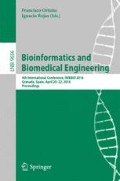Abstract
Dysregulation of apoptosis is a key attribute of cancer, especially the one induced by p53 expression disruption. Radiotherapy, sometimes supported by chemotherapy and/or pre-surgery, is recommended in majority of cases, but despite of the very well defined treatment protocols and high quality irradiation procedure, the huge dispersion in response to the radiotherapy is observed among cancer patients. Patient radiosensitivity, according to up-to-date knowledge, is at least partially responsible for different reactions to ionising radiation. Here we concentrate on investigation of single nucleotide polymorphisms (SNP) which can possibly explain the radiation response phenomena. To reach this goal dependent and independent methods of p-value integrations are presented and compared. Both statistical and molecular function domains are used in comparison study. We propose a novel method of p-value integration which includes the control of gene expression trend and introduces the adaptive significance level. What is more the multigene approach is proposed in contrary to classical single gene investigation. As a result, set of statistically significant polymorphisms was obtained, among which some were identified as possible deleterious for KRAS signalling pathway.
Access this chapter
Tax calculation will be finalised at checkout
Purchases are for personal use only
References
Pan, H., Yin, C., Van Dyke, T.: Apoptosis and cancer mechanisms. Cancer Surv. 29, 305–327 (1996)
West, C.M., Barnett, G.C.: Genetics and genomics of radiotherapy toxicity: towards prediction. Genome Med. 3(8), 52 (2011)
Bunz, F.: Principles of Cancer Genetics. Springer, The Netherland (2007)
Papiez, A., Kabacik, S., Badie, C., Bouffler, S., Polanska, J.: Statistical integration of p-values for enhancing discovery of radiotoxicity gene signatures. In: Ortuño, F., Rojas, I. (eds.) IWBBIO 2015, Part I. LNCS, vol. 9043, pp. 503–513. Springer, Heidelberg (2015)
Zaykin, D.V., Zhivotovsky, L.A., Czika, W., Shao, S., Wolfinger, R.D.: Combining p-values in large-scale genomics experiments. Pharm. Stat. 6(3), 217–226 (2007)
Whitlock, M.C.: Combining probability from independent tests: the weighted Z-method is superior to Fisher’s approach. J. Evol. Biol. 18(5), 1368–1373 (2005)
Chen, Z.: Is the weighted z-test the best method for combining probabilities from independent tests? J. Evol. Biol. 24(4), 926–930 (2011)
Budworth, H., et al.: DNA repair and cell cycle biomarkers of radiation exposure and inflammation stress in human blood. PLoS ONE 7(11), e48619 (2012)
O’Donovan, M.R., et al.: Extended-term cultures of human T-lymphocytes: a practical alternative to primary human lymphocytes for use in genotoxicity testing. Mutagenesis 10, 189–201 (1995)
Finnon, P., et al.: Evidence for significant heritability of apoptotic and cell cycle responses to ionising radiation. Hum. Genet. 123(5), 485–493 (2008)
Zyla, J., Badie, C., Alsbeih, G., Polanska, J.: Modelling of genetic interactions in GWAS reveals more complex relations between genotype and phenotype. In: Proceedings of the International Conference on Bioinformatics Models, Methods and Algorithms (BIOSTEC 2014), pp. 204–208 (2014). ISBN 978-989-758-012-3
Fisher, R.A.: Statistical Methods for Research Workers, 4th edn. Oliver and Boyd, Edinburgh (1932)
Brown, M.B.: 400: A method for combining non-independent, one-sided tests of significance. Biometrics 31, 987–992 (1975)
Kost, J.T., McDermott, M.P.: Combining dependent p-values. Stat. Probab. Lett. 60(2), 183–190 (2002)
Rüschendorf, L.: Random variables with maximum sums. Adv. Appl. Probab. 14, 623–632 (1982)
Vovk, V.: Combining p-values via averaging (2012). arXiv preprint arXiv:1212.4966
Segrè, A.V., Groop, L., Mootha, V.K., Daly, M.J., Altshuler, D., Diagram Consortium, Magic Investigators: Common inherited variation in mitochondrial genes is not enriched for associations with type 2 diabetes or related glycemic traits. PLoS Genet, 6(8), e1001058 (2010)
Subramanian, A., et al.: Gene set enrichment analysis: a knowledge-based approach for interpreting genome-wide expression profiles. PNAS 102(43), 15545–15550 (2005)
Heberle, H., et al.: InteractiVenn: a web-based tool for the analysis of sets through Venn diagrams. BMC Bioinform. 16(1), 169 (2015)
Jančík, S., Drábek, J., Radzioch, D., Hajdúch, M.: Clinical relevance of KRAS in human cancers. BioMed Res. Int. (2010). doi:10.1155/2010/150960
Chakrabarti, G.: Mutant KRAS associated malic enzyme 1 expression is a predictive marker for radiation therapy response in non-small cell lung cancer. Radiat. Oncol. 10(1), 1 (2015)
Okamoto, K., Zaanan, A., Kawakami, H., Huang, S., Sinicrope, F.A.: Reversal of mutant KRAS-mediated apoptosis resistance by concurrent Noxa/Bik induction and Bcl-2/Bcl-xL antagonism in colon cancer cells. Mol. Cancer Res. 13(4), 659–669 (2015)
Wang, G., et al.: LincRNA-p21 enhances the sensitivity of radiotherapy for human colorectal cancer by targeting the Wnt/β-catenin signaling pathway. Oncol. Rep. 31(4), 1839–1845 (2014)
Leszczynska, K.B., et al.: Hypoxia-induced p53 modulates both apoptosis and radiosensitivity via AKT. J. Clin. Invest. 125(6), 2385–2398 (2015)
Acknowledgement
This work was funded by NCN grant HARMONIA 4 no. DEC-2013/08/M/ST6/00924 (JZ, CB, JP). Calculations were carried out using infrastructure of GeCONiI (POIG.02.03.01-24-099/13).
Author information
Authors and Affiliations
Corresponding author
Editor information
Editors and Affiliations
Rights and permissions
Copyright information
© 2016 Springer International Publishing Switzerland
About this paper
Cite this paper
Zyla, J., Badie, C., Alsbeih, G., Polanska, J. (2016). Multigene P-value Integration Based on SNPs Investigation for Seeking Radiosensitivity Signatures. In: Ortuño, F., Rojas, I. (eds) Bioinformatics and Biomedical Engineering. IWBBIO 2016. Lecture Notes in Computer Science(), vol 9656. Springer, Cham. https://doi.org/10.1007/978-3-319-31744-1_12
Download citation
DOI: https://doi.org/10.1007/978-3-319-31744-1_12
Published:
Publisher Name: Springer, Cham
Print ISBN: 978-3-319-31743-4
Online ISBN: 978-3-319-31744-1
eBook Packages: Computer ScienceComputer Science (R0)

